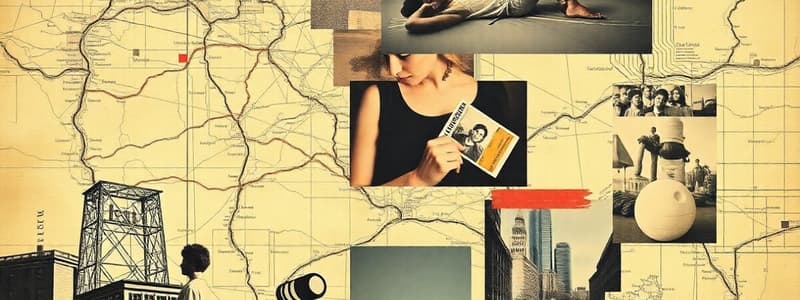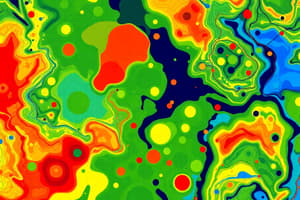Podcast
Questions and Answers
Which type of information is generally considered most direct and personal in gathering spatial data?
Which type of information is generally considered most direct and personal in gathering spatial data?
- Policy Documents
- Travel Narratives
- Media Reports
- Field Observation (correct)
What is a significant benefit of using geographic data in decision-making?
What is a significant benefit of using geographic data in decision-making?
- It generates public opinion data.
- It can explain the geographical effects of decisions. (correct)
- It provides immediate financial metrics.
- It replaces the need for field surveys.
Which option is an example of utilizing technology to visualize geographic data?
Which option is an example of utilizing technology to visualize geographic data?
- Web Map (correct)
- Landscape Analysis
- Personal Interviews
- Photographic Interpretation
Which source of information typically provides quantitative data about populations and demographic trends?
Which source of information typically provides quantitative data about populations and demographic trends?
What would NOT be considered a method of gathering spatial information?
What would NOT be considered a method of gathering spatial information?
Which type of map primarily emphasizes the spatial distribution of a particular phenomenon or data?
Which type of map primarily emphasizes the spatial distribution of a particular phenomenon or data?
What term describes the pattern where items are evenly spaced across a given area?
What term describes the pattern where items are evenly spaced across a given area?
Which of the following best describes a potential distortion caused by map projections?
Which of the following best describes a potential distortion caused by map projections?
What does the concept of 'absolute distance' refer to in geographic terms?
What does the concept of 'absolute distance' refer to in geographic terms?
How do reference maps differ from thematic maps?
How do reference maps differ from thematic maps?
Which geographic scale refers to an analysis of multiple countries or a portion of a country?
Which geographic scale refers to an analysis of multiple countries or a portion of a country?
What type of region is defined by people's perceptions and sense of place?
What type of region is defined by people's perceptions and sense of place?
Which statement best describes formal regions?
Which statement best describes formal regions?
What is the primary challenge geographers face when defining regions?
What is the primary challenge geographers face when defining regions?
Which of the following is NOT a geographic scale mentioned in the content?
Which of the following is NOT a geographic scale mentioned in the content?
Which concept explains the phenomenon where the impact of a particular event diminishes as distance increases?
Which concept explains the phenomenon where the impact of a particular event diminishes as distance increases?
What is a primary distinction between absolute and relative locations?
What is a primary distinction between absolute and relative locations?
Which of the following concepts emphasizes the potential for human adaptation to environmental conditions?
Which of the following concepts emphasizes the potential for human adaptation to environmental conditions?
What would be classified as a scaling approach in geographic analysis?
What would be classified as a scaling approach in geographic analysis?
What is the primary goal of studying relationships and patterns among places in geography?
What is the primary goal of studying relationships and patterns among places in geography?
Which term refers to the concept of interconnections and flows between people, goods, and information in geography?
Which term refers to the concept of interconnections and flows between people, goods, and information in geography?
How do geographers specifically utilize maps in their analysis?
How do geographers specifically utilize maps in their analysis?
Which statement best describes how geographers apply a spatial perspective?
Which statement best describes how geographers apply a spatial perspective?
Why is identifying spatial patterns important for geographers?
Why is identifying spatial patterns important for geographers?
What is one primary component that geographers consider when analyzing complex issues?
What is one primary component that geographers consider when analyzing complex issues?
Flashcards
Geographic Information System (GIS)
Geographic Information System (GIS)
A computer specialized for handling geographic data, including capturing, storing, analyzing, and displaying it.
Field Observation
Field Observation
Collecting information about a place by directly observing it.
Landscape Analysis
Landscape Analysis
Examining the features and characteristics of a landscape to understand its significance.
Photographic Interpretation
Photographic Interpretation
Signup and view all the flashcards
Geographical Effects of Decisions
Geographical Effects of Decisions
Signup and view all the flashcards
Reference Maps
Reference Maps
Signup and view all the flashcards
Thematic Maps
Thematic Maps
Signup and view all the flashcards
Absolute Distance
Absolute Distance
Signup and view all the flashcards
Relative Distance
Relative Distance
Signup and view all the flashcards
Geographic Data Collection
Geographic Data Collection
Signup and view all the flashcards
Regional Analysis
Regional Analysis
Signup and view all the flashcards
Formal/Uniform/Homogeneous Regions
Formal/Uniform/Homogeneous Regions
Signup and view all the flashcards
Functional Regions
Functional Regions
Signup and view all the flashcards
Perceptual/Vernacular Regions
Perceptual/Vernacular Regions
Signup and view all the flashcards
Geographic Scales
Geographic Scales
Signup and view all the flashcards
Absolute Location
Absolute Location
Signup and view all the flashcards
Relative Location
Relative Location
Signup and view all the flashcards
Distance Decay
Distance Decay
Signup and view all the flashcards
Time-Space Compression
Time-Space Compression
Signup and view all the flashcards
Environmental Determinism
Environmental Determinism
Signup and view all the flashcards
Geographic Relationships
Geographic Relationships
Signup and view all the flashcards
Maps and Patterns
Maps and Patterns
Signup and view all the flashcards
Spatial Perspective
Spatial Perspective
Signup and view all the flashcards
Interconnections on Earth
Interconnections on Earth
Signup and view all the flashcards
Analyzing Spatial Patterns
Analyzing Spatial Patterns
Signup and view all the flashcards




